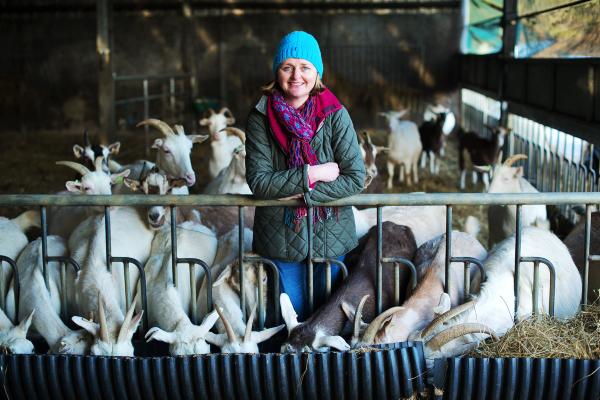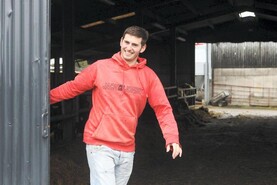With 220 milking goats at her farm in Inagh, Co Clare, and as mum to son Caoilte (seven) and daughter Luisne (three), Siobhan Ní Ghairbhith admits she has her work cut out between her kids of the two- and four-legged variety.
“Though the two-legged ones are much more demanding,” she laughs, stroking the downy head of one of her doe-eyed herd, whose Burren-flavoured milk is the secret of St Tola farmhouse cheese’s success. (Although a sign in the office that proclaims “To Relieve Stress: Bang Head Here” suggests it isn’t always a stroll in the Burren either.)
But while St Tola clinched the supreme champion accolade at last year’s Irish Cheese Awards, Siobhan admits she was far from a connoisseur when she left her teaching post in the ’90s to take over the brand.
“My whole focus with St Tola is very much back to the basics of doing something with the land,” she explains, as she succinctly slices off taster samples on a slate cheeseboard; starting with a mild crottin, followed by a creamy feta-style cheese and culminating in the ash log, which is actually rolled in food-grade charcoal and has sent chefs and cheesemongers spinning.
“But I wasn’t a foodie by any means, and I didn’t know anything about cheese,” she admits.
Taking Chances
Indeed, Siobhan’s grandfather first came to Inagh to teach in a primary school just 200 metres from where she now farms.
Her parents were both teachers and while they kept a few cows for their own use (Siobhan recalls fighting her five siblings for the cream on top of the milk jug), most of their 65-acres were leased.
However, in her mid-20s, Siobhan felt an irresistible tug back to the land.
“I just thought it was an awful pity that one of the six of us wasn’t doing something with the farm,” she says. “I was always a country girl at heart and the more I thought about it, the more I thought there’s probably an opportunity to do something here.’”
By fate or fortune, Siobhan’s neighbours Meg and Derrick Gordon were retiring from St Tola, a farmhouse cheese brand they had established in the 1980s. As a teenager, Siobhan worked at St Tola during summer holidays, although reveals that the only cheese brands she was familiar with prior to that were Laughing Cow, Easy Singles and Calvita.
Taking over an established company had obvious advantages, but it also had costs in maintaining standards for high-end stockists like Neal’s Yard in London.
In fact, Siobhan estimates that to take over the brand, buy in new animal stock, erect a purpose-built cheesehouse and shed and bring her own family farm to organic standards, saw a not-for-the-faint-hearted investment of £500,000 – albeit with 50% grant-aided by groups like Shannon Development, LEADER and Clare County Enterprise Board, 40% through loans and 10% through personal savings.
Little wonder then that people questioned her decision to give up her teaching job and take that risk.
“Dad at the time said: ‘What is Siobhan doing after getting a secure, pensionable job?’” she recalls.
“But in your mid-20s, you think the world is your oyster and you don’t think about the secure, pensionable job, or children down the road.
“Also, my partner John Harrington had been a secondary school teacher, but had gone into shellfish farming (Kush Seafoods) and he encouraged me, because all my aunts and uncles, bar one, were teachers, so we had no knowledge of going out into the brave world of business.
“But as I’ve always said to John, we’re the kind of people who will turn our hand to anything. If we have to sweep the streets to get money, we will do it.”
Farmers’ market to supermarket
From the start, Siobhan was determined to make St Tola available to the average consumer.
“I never wanted St Tola just to be exclusive to people who could afford to eat in fancy restaurants or go to speciality shops,” she explains.
Of course, many artisans have failed to make the transition to the supermarket. Siobhan’s biggest challenge was to introduce a product that “was suitable for sitting on the shelves of supermarkets and being thrown into the shopping trolley along with your baked beans and your firelighters”.
She managed that by reinventing the St Tola logo, having more durable packaging and introducing a spreadable cream cheese without sacrificing its handcrafted credentials.
Another smart move was teaming up in 2010 with Cashel Blue, Wicklow Farmhouse Cheese, Carrigbyrne Cheese, Milleens and, more recently, the Little Milk Company, to form Irish Cheese Direct to target the multiples, splitting expenses like distribution, IT and the cost of a part-time staff member.
St Tola is now listed by Tesco, SuperValu and Superquinn, and Siobhan believes that such co-operation is the way forward for smaller artisans that are struggling to make a mark on the retail market.
“Up until that, farmhouse cheesemakers had been going through wholesalers,” says Siobhan.
“But we weren’t able to sell our products as well as we felt we could sell ourselves.”
Other recent developments include a farm shop, a school and visitor tours as part of the Burren Food Trail.
“Basically, trying to get more financial reward for the hard work that everyone is doing here,” says Siobhan, who employs five full-time staff. Of course, there are constant challenges. For example, the difficulty of controlling rushes on the farm may well mean splitting production between organic and non-organic this year, while maintaining sustainable farming practice throughout.
As far as advice to other artisans goes, Siobhan believes you need to offer something truly unique and be realistic about whether it’s a viable business or a hobby.
“You have to treat yourself as if you were treating an employee, and you have to put a value on your own time,” she says. “If it’s a source of income, it can’t be a charity.”
Despite the realities of business, it seems that Siobhan is still that dreamer who took over St Tola to just make something of her family farm.
“They react to kindness,” she says, giving one of her goats a soft pat. “But I think anything alive, really, reacts to kindness.”






 This is a subscriber-only article
This is a subscriber-only article















SHARING OPTIONS: